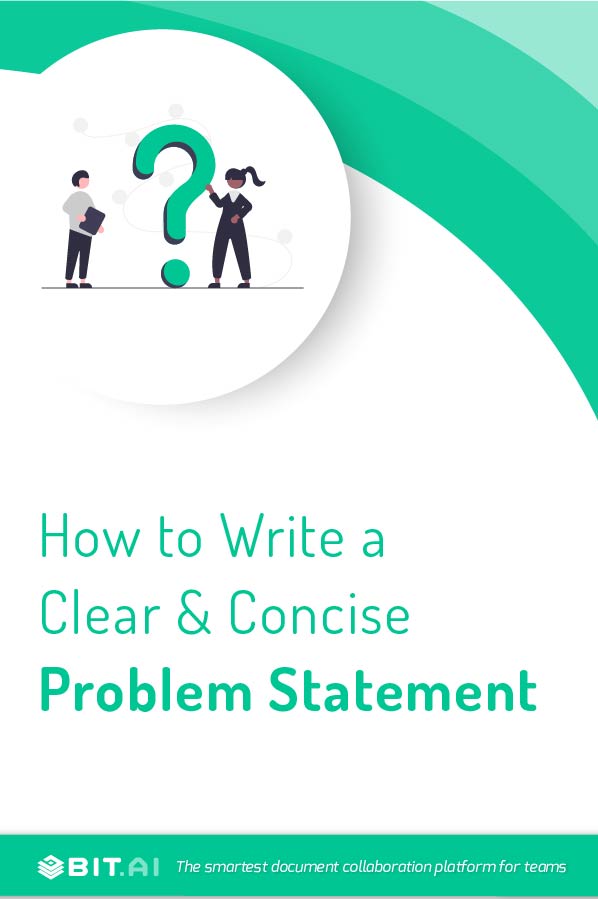What’s the first step in every research? Yes, you guessed it right! Every research begins with identifying a problem or an existing gap in your field of study.
Once you have identified the problem, the next step is to craft a statement of this problem, aka a ‘problem statement’. This statement explores the issue and how you are planning to solve it.
A problem statement is undoubtedly the foundation of every systematic investigation. Every research paper or proposal needs to clearly identify the problem, and describe it – along with the solution.
This statement helps the reader understand why the research has been conducted, why it’s relevant, if the methods and techniques used are appropriate, and if the results are valid.
As a problem statement is the core of your study, you need to learn how to write a good one. So, where do you start? Well, first you need to acquaint yourself with what exactly this statement is, its elements, and its structure.
First Off, What is a Research Problem?
A research problem is either a gap in existing knowledge that needs to be filled or an issue with certain processes or practices that need a solution. It could also be earlier findings and existing phenomenons that need to be further investigated. Basically, it’s a contrast between what is and what should be.

In simple words, a research problem is a situation that requires a solution, and for which solutions are available. After all, if a situation doesn’t have any possible solutions, then it makes no sense to conduct research on it. Your approach to the problem could be theoretical or practical, and it entirely depends on your research paper.
Okay, So What is a Problem Statement?
A problem statement, also known as a statement of the problem, is a description of the research problem. It provides the context for the research paper and states the questions that the research intends to answer. In short, this statement encapsulates the central focus of your research.
While a problem statement is usually just one sentence, it needs to be backed up by several paragraphs that explain the problem. It should establish the foundation for everything that your research paper would cover!
Most importantly, the statement should only address one specific issue and contribute to the existing knowledge pool. It shouldn’t be too broad or too vague. To sum it up, here are four characteristics that a good problem statement has:
- It should lead to further research and investigations.
- It should suit the skills and interests of the researcher.
- It should address a gap in existing knowledge.
- It should significantly contribute to the existing knowledge pool.
The major difference between a problem statement and a thesis statement is that the former focuses on a particular issue, and aims to resolve it with the research. Whereas, the latter makes a specific claim and assertion that is open for debate.
For instance, ‘writing is more of a science than an art’ is a thesis statement, as it explores an idea that might be true or false. Basically, once you establish the thesis statement, you are required to provide evidence and build up an argument to support your claim.
Read more: Statement of Work: What is it & How to Write it? (Template Included)
Hmm…What Are The Goals of a Problem Statement?
The goal of a problem statement is simple – change a general problem into one that can be fixed through research. Writing a problem statement serves the researcher, readers as well as potential investors.
For the researcher, the problem statement helps in laying out the scope of the project. Moreover, it allows you to understand the aims and objectives of your study.
From the reader’s point of view, a problem statement helps in understanding the core reason behind the research and the issues that the research is going to address.
Lastly, a problem statement can help potential investors decide whether they should invest in your research or not. It gives them a brief overview of the existing knowledge gap and how you aim to fill the gap.
Cool! What Are The Key Elements of a Problem Statement?
1. Context
It goes without saying – your problem statement needs to have context. You’ve to provide the readers with the information they require to understand why you want to fix a particular problem and why it needs to be fixed.
If there have been earlier attempts at solving the same problem, or if there are existing solutions that need some improvement, you can mention this information here.
If you’re conducting applied research, your problem statement should talk about where a certain problem happens, and who gets affected by it.
On the other hand, if it’s basic/theoretical research, you need to cite all the relevant literature on the topic and tell the reader which gap in existing knowledge you want to address through the study.
2. Relevance
Your problem statement should clarify why your research matters. Ask yourself: what is going to happen if the problem persists, and who will face the consequences?
Once you find the answer, communicate it to your readers through the problem statement. Long story short, explain to your readers how your study fits into the bigger picture.
Read more: User Research: Definition, Importance & Methods!
3. Aims and Objectives
Well, now that the reader knows the context of your research and why it matters, talk about the design and methods that you’ve used in the study. Make sure that no important details are left out!
Most importantly, bring every element of your paper together so that the reader can decide if they understand the motive behind your study and if they’re convinced by your approach.
But, How Do I Write a Good Problem Statement?
Step 1. Define The Context
As we said above, the first thing that you need to do while writing a problem statement is – build a solid context. This would make it easier for the readers to understand the problem.
Here’s a trick: Start by describing an ideal world where the problem doesn’t exist. Help your readers understand how better things would be if they didn’t have to face this particular problem.
For instance, if your study is about the rise in the number of car accidents in Manhattan, you can start by describing how safe everything would be if the problem didn’t exist.
Step 2. State Why the Problem Matters
The next thing that you need to do is explain why the problem matters so much, and why it’s important to address it. Simply put, answer the following questions:
Why is it so important to fix this issue at the moment? What difference would it make? Is it going to change anything? Is it going to make lives better?
Here, you can also include the attempts that were previously made to resolve the problem, and why they didn’t work out or need to be improved.
Step 3. State the Financial Cost
If there’s a financial consequence that might arise if the problem isn’t fixed, it’s a good idea to mention it here. This is super useful especially if you’re pitching your research to investors!
Step 4. Back Up Your Claims
Saying that the problem would have a negative impact on people or an organization isn’t enough – you need to back up your claim with facts and data. Pull up all the information from your secondary data sources, and reference them in the statement.
Step 5. Offer a Solution
Now that you’re clear about which problem needs to be fixed, the next question is, how can you fix it? You need to suggest a practical and realistic solution to the problem.
Also, mention why your solution is the best, and why it will work effectively. Throw some light on the impact your solution would have and its benefits.
Step 6. Summarize The Problem and Solution
In the conclusion of your statement, outline the problem, why it needs to be resolved, and why your solution is the best way to solve the problem.
Wrapping Up
A problem statement establishes the tone for the rest of your research paper – so you need to make sure that it is perfect. Whether you want funding for your research paper or approval from your professor, writing a good problem statement is of utmost importance!
Remember that your problem statement is the one thing that will allow you to explain the essence of your study, and prove to the readers why it’s worth being addressed. With that said, here are a few things you should know while crafting a problem statement:
- Make sure that the statement is straight to the point.
- Each and every word should reinforce how important your study is.
- Don’t forget to emphasize the ‘why’ aspect of the problem you’re planning to address.
- Narrow the scope of your statement and try to address only one specific problem.
- Avoid using highly technical language and unnecessary jargon.
- Back up your argument with facts and figures that will convince the reader.
That’s it, folks! If you’ve got any questions, queries, or suggestions – don’t forget to hit us up on Twitter @bit_docs. We would be happy to help you out.
This blog was written by the Bit.ai team. Bit.ai is a powerful documentation and collaboration platform where you and your team can easily create, access, share, and manage all your documents under one roof. To learn more about this wonderful platform, visit Bit.ai.
Further reads:
How to Write a Thesis with Perfection?
Purpose Statement: What is it & How to Write it? (Format & Steps)
User Persona: What is it & How to Create it?
Marketing Research: Definition, Process & Tools!
Target Audience: What is it and How to Find them? (Steps Included)
Top 13 Tools for Researchers in 2022

Related posts
Bit.ai | Watch to Learn More
What is Bit.ai?
Bit.ai is an innovative AI-driven knowledge and Document Managment suite designed to empower knowledge workers by streamlining the creation of, documents, wikis, and notes. With an intuitive interface and seamless integration, Bit.ai acts as a versatile assistant to help you collaborate, generate, organize, and visualize your ideas effortlessly. Whether you are drafting a report, managing a project, collaborating with your team or clients, or brainstorming new concepts, Bit.ai brings intelligence and creativity to every aspect of your work process.




